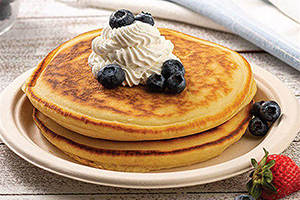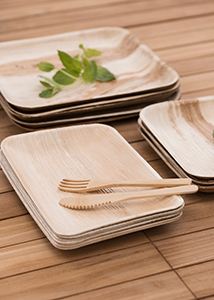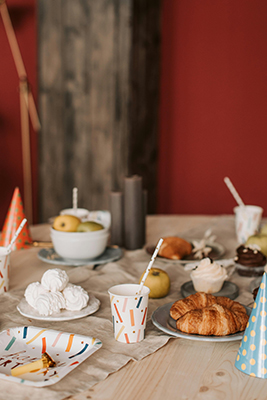Categories
New Blog
The Eco-Friendly Battle: Sugarcane Plates vs. Palm Leaf Plates vs. Paper Plates
March 22 , 2024Eco-friendly plates have become increasingly popular as consumers seek alternatives to traditional single-use plastic options. Among the most notable choices are sugarcane plates, palm leaf plates, and paper plates. Each of these options boasts its own set of environmental benefits and drawbacks. In this comparison, we delve into several aspects of these three types of plates to help you make an informed decision about which option aligns best with your business eco-conscious values.
Here's a comparison table for Sugarcane Plates, Palm Leaf Plates, and Paper Plates:

Sugarcane plates, also known as bagasse plates, are made from the fibrous residue left behind after sugarcane stalks are crushed to extract their juice. These plates are sturdy, microwave-safe, and biodegradable, making them a popular choice for eco-conscious consumers.
Renewable Resource: Sugarcane is a fast-growing grass that regenerates quickly, making it a sustainable material for plate production.
Biodegradable: Since sugarcane plates are made from natural plant fibers, they break down easily in composting environments, reducing the burden on landfills.
Microwave-Safe: Unlike some other eco-friendly alternatives, sugarcane plates are microwave-safe, providing convenience without compromising sustainability.
Sturdy: Sugarcane plates are durable enough to hold hot or oily foods without becoming soggy or losing their shape.
Energy Intensive Production: While sugarcane itself is a renewable resource, the process of converting it into usable plates requires energy and resources, which may have environmental implications.
Chemical Treatments: Some sugarcane plates are coated with bioplastic or other chemicals to enhance their durability or water resistance. While these coatings are often biodegradable, they may still raise concerns about chemical exposure.
Sugarcane Bagasse Plates Manufacturing Process:
you can read this article to know more: How to Make Plates From Sugarcane Waste?

Palm leaf plates are crafted from fallen palm leaves, typically sourced from naturally shed leaves of the Areca palm tree. These plates are rustic in appearance and offer a unique, natural alternative to traditional disposable tableware.
Biodegradable: Like sugarcane plates, palm leaf plates are biodegradable and compostable, making them an eco-friendly choice for disposable tableware.
Natural Appearance: Palm leaf plates have an attractive, earthy aesthetic that adds a touch of rustic charm to any dining setting.
No Chemical Treatments: Since palm leaf plates are made from natural palm leaves, they do not require chemical treatments or additives, reducing concerns about chemical exposure.
Sturdy: Palm leaf plates are sturdy and heat-resistant, making them suitable for a wide range of hot and cold foods.
Limited Availability: Palm leaf plates may be less readily available than other disposable tableware options, particularly in areas where palm trees do not grow naturally.
Transportation Impact: Depending on the location of production and consumption, the transportation of palm leaf plates may have environmental implications due to carbon emissions associated with shipping.
While palm leaf plates are typically intended for single-use, they are durable enough to withstand light washing and reuse for certain purposes. However, their lifespan may vary depending on usage and cleaning methods.

Paper plates are a classic disposable tableware option, widely available and familiar to consumers around the world. While traditional paper plates are not always the most eco-friendly choice, there are now many options made from recycled or sustainably sourced materials.
Recyclable: Paper plates made from recycled materials can be recycled again after use, reducing the demand for virgin materials and minimizing waste.
Widely Available: Paper plates are readily available at most grocery stores and supermarkets, making them a convenient choice for consumers.
Customizable: Paper plates can be easily customized with designs or branding, making them a popular choice for parties, events, and picnics.
Limited Durability: Paper plates are prone to becoming soggy when exposed to liquids or oily foods, potentially leading to messes or food waste.
Resource Intensive: While paper plates made from recycled materials offer environmental benefits, the production of paper itself requires significant resources, including water and energy.
Coating Concerns: Some paper plates are coated with plastic or wax to improve their durability or moisture resistance. While these coatings may make the plates more functional, they can also complicate recycling efforts and raise concerns about environmental impact.
While some paper plates are specifically designed to be microwave-safe, it's essential to check the packaging or label before using them in the microwave. Microwaving non-microwave-safe paper plates can lead to scorching, burning, or even fires, posing safety risks.
When it comes to selecting the ideal tableware for your business, several factors must be taken into account, including sustainability, durability, aesthetics, and cost-effectiveness. While each material—sugarcane plates, palm leaf plates, and paper plates—offers its own set of advantages and considerations, prioritizing sustainability and environmental responsibility is paramount in today's green-conscious market.
Both sugarcane plates and palm leaf plates emerge as frontrunners in terms of eco-friendliness, biodegradability, and aesthetic appeal. Their natural origins, coupled with their robust construction and versatility, make them ideal choices for businesses seeking to align with sustainable practices while enhancing the dining experience for their customers.
On the other hand, while paper plates offer convenience and affordability, their environmental impact and limited durability make them less desirable from a sustainability standpoint. Businesses looking to minimize their carbon footprint and promote responsible consumption may find sugarcane plates and palm leaf plates to be more suitable alternatives in the long run.
Sugarcane bagasse plates come in a variety of shapes and sizes to suit different serving needs. Here are some recommended options:
These round plates are durable and microwave-safe, making them suitable for both hot and cold foods. They can be used for a wide range of dishes, from appetizers and salads to desserts and snacks. They come in various sizes and are compostable, making them an excellent eco-friendly option for events or gatherings.
Recommendation:
9" 10" Disposable Round 3 Grid Eco Bagasse Plates
6” 7” 8” Biodegradable Sugarcane Bagasse Round Patterned Plate For Cake
6" 7" 9" 10" Eco-Friendly Round Biodegradable Sugarcane Plate
These compostable plates are made from 100% natural sugarcane bagasse and come in various sizes suitable for serving appetizers, main courses, or desserts. They are sturdy and can hold hot or cold foods without getting soggy.
Recommendation:
Rectangle Biodegradable 10 Inch Sugarcane Bagasse Plate For Lunch
7” Compostable Disposable Popular Sugarcane Bagasse Plates
These oval plates are biodegradable and compostable. They have a sleek design and are suitable for serving salads, sandwiches, or small entrees. They are stylish and eco-friendly alternative to traditional serving trays.
Recommendation:
Compostable Oval Party Sugarcane Bagasse Plate
Eco Friendly Biodegradable Oval Bagasse Takeout Dinner Plate
Square bagasse plates offer a modern and sleek aesthetic, perfect for contemporary dining environments or upscale events. These square plates are sturdy and can hold saucy or greasy foods without leaking.
Recommendation:
6" 8" 10" Square Compostable Bagasse Wedding Plates
Compostable Fruits Vegetables Bagasse Pulp Square Plates
3” 5” 7” Disposable Biodegradable Sugarcane Pulp Square Plate For Cake
In conclusion, the choice between sugarcane plates, palm leaf plates, and paper plates ultimately depends on your business's values, priorities, and customer preferences. By opting for sustainable tableware solutions like sugarcane plates or palm leaf plates, you not only demonstrate your commitment to environmental stewardship but also contribute to a greener, more sustainable future for generations to come.